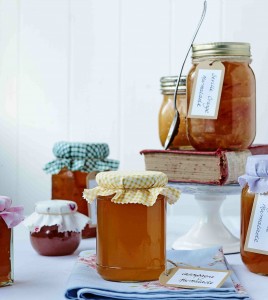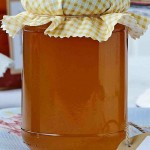One of the most evocative seasonal foods featured in our January e-zine was Seville oranges, such a precious fruit as their season is so short and their uses so specific. Marmalade is by far their most popular use and plenty of questions about the details of the marmalade-making process followed – and one reader had lost his dog-eared copy of my own favourite recipe, so I’m sharing it again below. I have always loved making marmalade, and relished the way the aroma of the slow-cooking oranges scents everything throughout the house. It’s something I started to enjoy at a very early age, with my mother, and readers’ queries have reminded me of the value of favourite old tried-and-tested recipes, hands-on teaching – and the importance of understanding the principles behind a recipe rather than just following instructions slavishly and hoping for the best…
Favourite Mincer Marmalade:
This recipe is the one I normally use, as it is easy and convenient, whether made with fresh or frozen oranges. Quantities given make about 9 lb/4.1 Kg marmalade, but it is handy to double them if you have a suitable pan.
2 large lemons
3 lb/1.4 Kg bitter oranges
5 pints/3 litres water
6 lb/2.7 Kg granulated sugar
Squeeze lemons and reserve juice. Scrub oranges and pick the discs off the stalk ends, then put the whole oranges and lemon peel into a large, heavy-based pan and cover with 4 pints/2.3 litres of the water. Cover, bring to the boil and simmer for about 11/2 hours, or until the peel is quite soft. Lift oranges and lemon peel out with a slotted spoon, reserving the liquid. Halve the oranges as soon as they are cool enough to handle and scoop out the flesh and pips into a smallish pan. Add the remaining l pint/600ml of water, bring to the boil and simmer for 10 minutes to extract the pectin from the pith and pips. Cut up the softened peel as coarsely or as finely as you like, or put it through a mincer. (This looks messy at the time, but works out OK; you could also use a liquidiser/food processor but you have to be very careful not to purée the peel). Put the prepared peel back into the pan containing the cooking liquid, then add the sugar, lemon juice and the strained juice from the pith and pips mixture. Stir over low heat until dissolved (this will be quicker if the sugar has been warmed in a low oven beforehand), bring to the boil and boil fast for about 15-20 minutes until setting point is reached. Take the pan off the heat and allow to cool for 10-15 minutes, then stir well to distribute the fruit evenly and use a small jug to pour it into clean warm jars. Small waxed discs may be put on top of the marmalade immediately, but don’t cover with cellophane or lids until absolutely cold, as this reduces the chance of condensation forming and consequently the risk of mould formation during storage. Label and store in a cool, dark place.
Hints for success with marmalade:
- Cooking citrus fruit takes much longer than other fruits because of the thickness of the peel, so much more water is needed to allow for evaporation. By the end of the first cooking stage, the contents of the pan should be reduced by half and the peel must be very soft – once the sugar is added, the peel will not soften any more.
- Pectin and acid content is important to obtain a good set in all jam and marmalade making; lemon juice is added to Seville orange marmalade to supply the extra acid needed to get a good set and prevent crystallisation.
- When the sugar is added it must be dissolved over low heat before bringing the temperature up to the boil. Once dissolved, a fast rolling boil is needed to bring the marmalade up to boiling point. To allow for safe fast boiling, the reduced pulp should not come more than halfway up the pan. If you don’t have a big heavy-based pan suitable for preserves, why not consider sharing one with friends or relatives?
- The longer you boil, the darker the colour and more ‘mature’ the flavour, but over-boiling produces a half-set, syrupy preserve. If your marmalade has reached setting point and you prefer it darker, add a spoonful or two of treacle instead of boiling longer.
- Setting point is reached when a sugar thermometer reaches 221ºF, 105ºC, or when a little jam cooled on a cold saucer wrinkles when pushed with a finger or spoon.
- To keep well, the marmalade must be poured into jars which are clean, dry and warm, then left until completely cold before covering. (Alternatively they may be sealed when very hot, but never when lukewarm as condensation is more likely to form and cause moulding.) Store in a cool, dark place.
- Even if you haven’t time to make marmalade at the time, buy the oranges available as the season is very short and they freeze well – just make sure that you choose a recipe (such as the Favourite Mincer Marmalade given) which involves cooking the oranges whole, and freeze them in weighed batches. If they’re likely to be in the freezer for a long time, add an extra orange or two per batch to allow for any loss of pectin during storage – or add a couple of sweet oranges or grapefruit at the time if you leave them longer than anticipated.










